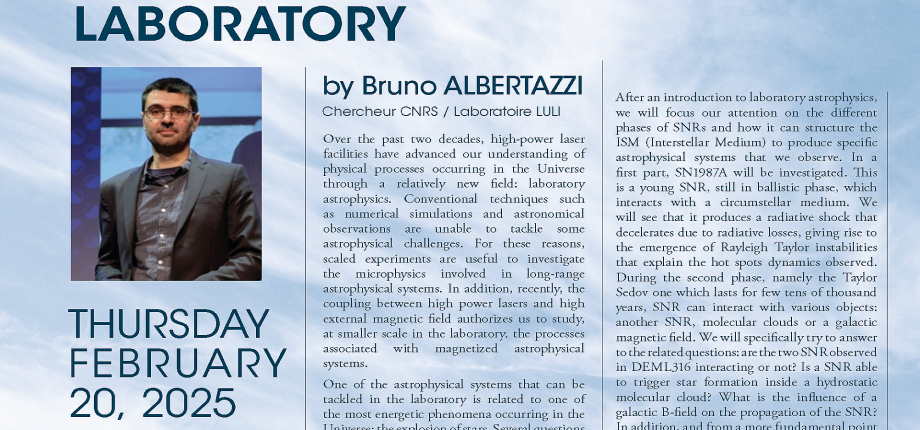Death and birth of stars : from the cosmos to the laboratory

Death and birth of stars : from the cosmos to the laboratory
by Bruno ALBERTAZZI Chercheur CNRS / Laboratoire LULI
Over the past two decades, high-power laser facilities have advanced our understanding of physical processes occurring in the Universe through a relatively new field: laboratory astrophysics. Conventional techniques such as numerical simulations and astronomical observations are unable to tackle some astrophysical challenges. For these reasons, scaled experiments are useful to investigate the microphysics involved in long-range astrophysical systems. In addition, recently, the coupling between high power lasers and high external magnetic field authorizes us to study, at smaller scale in the laboratory, the processes associated with magnetized astrophysical systems. One of the astrophysical systems that can be tackled in the laboratory is related to one of the most energetic phenomena occurring in the Universe: the explosion of stars. Several questions regarding the interaction of SNR (Supernovae Remnants) with surrounded environments (circumstellar medium, another SNR, molecular clouds and magnetic fields) remain unsolved.
After an introduction to laboratory astrophysics, we will focus our attention on the different phases of SNRs and how it can structure the ISM (Interstellar Medium) to produce specific astrophysical systems that we observe. In a first part, SN1987A will be investigated. This is a young SNR, still in ballistic phase, which interacts with a circumstellar medium. We will see that it produces a radiative shock that decelerates due to radiative losses, giving rise to the emergence of Rayleigh Taylor instabilities that explain the hot spots dynamics observed. During the second phase, namely the Taylor Sedov one which lasts for few tens of thousand years, SNR can interact with various objects: another SNR, molecular clouds or a galactic magnetic field. We will specifically try to answer to the related questions: are the two SNR observed in DEML316 interacting or not? Is a SNR able to trigger star formation inside a hydrostatic molecular cloud? What is the influence of a galactic B-field on the propagation of the SNR? In addition, and from a more fundamental point of view, how is a blast wave shaped by MHD (Magnetohydrodynamics) processes?
https://portail.polytechnique.edu/physique/fr/seminaire-de-physique




